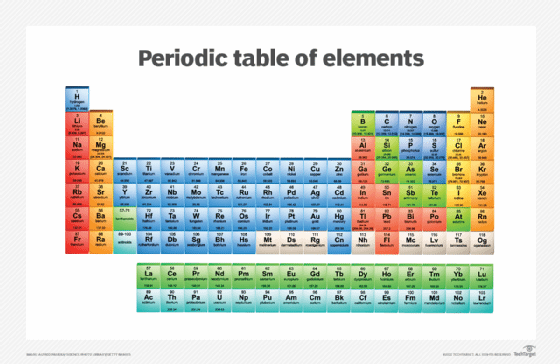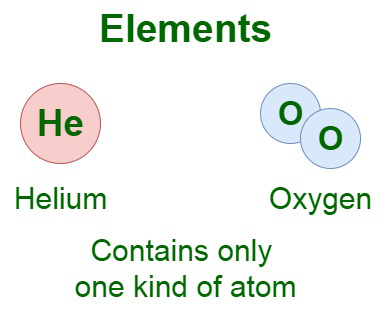Have you ever wondered why elements have the names they do? Maybe you’ve looked at the periodic table and been struck by how some elements seem to have obvious names like “iron” or “gold,” while others feel like they came out of a fantasy novel, like “yttrium” or “plutonium.” The truth is, the naming of elements is a fascinating journey through history, discovery, and scientific understanding.

Image: www.techtarget.com
I remember my first encounter with the periodic table, a confusing grid of letters and symbols. I was lost, trying to wrap my head around the concept of atoms and elements. As I began to dive deeper, I realized that the names were more than just labels; they were windows into a rich history of scientific exploration and discovery. Today, we’ll delve into the evolving world of element names, unraveling the factors that influence their creation, change, and sometimes even controversy.
The Origins of Element Names: From Ancient Times to Modern Discovery
The history of element naming is as old as civilization itself. Ancient civilizations, like the Greeks and Romans, recognized certain substances like gold, silver, and iron that they named based on their perceived properties or origin. As civilizations progressed, alchemists and early chemists continued to discover and name new elements. This was often a chaotic process, with names based on color, appearance, or even mythical figures.
During the 18th and 19th centuries, a surge in scientific advancements led to a more systematic approach to element naming. Scientists began to understand the fundamental nature of elements and their role in chemical reactions. In this period, many element names stemmed from geographical locations, like “germanium” (after Germany) and “polonium” (after Poland), or from notable scientists, such as “curium” (after Marie Curie).
Modern Nomenclature: The International Union of Pure and Applied Chemistry
Today, the naming of elements is a highly regulated process overseen by the International Union of Pure and Applied Chemistry (IUPAC). The IUPAC’s role is crucial in ensuring uniformity and clarity in chemical communication. The organization sets specific guidelines for naming newly discovered elements, prioritizing a systematic approach to avoid confusion and maintain scientific rigor.
The IUPAC’s guidelines emphasize the following criteria for naming elements:
- Latin or Greek roots: Names are often derived from Latin or Greek terms that reflect the element’s properties or origin.
- Discoverer’s suggestion: The discoverers of new elements typically propose a name, subject to IUPAC approval.
- Mythological figures: Names can honor mythological figures with relevance to the element’s properties.
- Other scientific concepts: Names can also incorporate scientific concepts linked to the element’s discovery or properties.
The IUPAC’s rigorous process ensures that new element names are scientifically sound and reflect the evolving understanding of chemistry. This is exemplified by the recent naming of elements 114 and 116. Element 114 was initially proposed to be named “flerovium” after the Flerov Laboratory of Nuclear Reactions in Russia, but the IUPAC ultimately decided to name it “flerovium” to honor the contributions of the laboratory’s founder, Georgy Flyorov.
Beyond the Basics: Controversies and Challenges in Element Naming
The process of naming elements isn’t always straightforward. There have been a number of instances where disputes have arisen over proposed names. One notable example is the case of element 106, which was discovered independently by two teams of scientists — one in the United States and one in the Soviet Union.
Both teams proposed different names, leading to a protracted debate that only resolved after the IUPAC intervened. Finally, the name “seaborgium” was adopted to honor Glenn Seaborg, a prominent American chemist and Nobel laureate.
The process of naming elements not only reveals scientific advancements but also the complexities of international collaboration and scientific diplomacy. It showcases how scientific discoveries can lead to both celebration and sometimes even conflict.

Image: es.acervolima.com
Understanding Element Names: A Window into Science
Learning about the evolution of element names provides a unique perspective on the history of scientific discovery and the ongoing quest for understanding the building blocks of our universe.
Understanding how element names are chosen offers a glimpse into the rigorous process of scientific inquiry and the essential role that international cooperation plays in advancing our knowledge.
Tips for Understanding Element Names
If you want to better understand the names of elements, here are some helpful tips:
- Explore the history: Research the origin of the element’s name; discover what inspired its selection.
- Delve into the properties: Connect the element’s name to its unique properties. For example, “chlorine” literally means “greenish-yellow” in Greek, a reference to its color.
- Focus on the symbolism: Explore the symbolism behind the element’s name. For example, “helium” was named after the Greek word for “sun.” This hints at its discovery in the sun’s spectrum.
By following these simple steps, you can transform your understanding of element names from a list of unmemorable symbols into a fascinating journey through the history of science and the evolution of our understanding of the world around us.
FAQs
Q: How are new elements discovered?
A: New elements are typically discovered in the lab by bombarding atoms of existing elements with particles, creating heavier atoms with more protons, neutrons, and electrons.
Q: Can element names be changed?
A: While element names are generally permanent, there have been instances where the IUPAC has made changes to existing names due to scientific evidence or historical context.
Q: What is the significance of element naming?
A: Element naming highlights the process of scientific discovery, reflects our understanding of element properties, and contributes to the consistent vocabulary of chemistry.
What Causes The Element Name To Change
https://youtube.com/watch?v=49G1fnFDSRg
Conclusion
As we explored the fascinating world of element naming, we discovered a history of discovery, scientific innovation, and the constant pursuit of understanding the world around us. Element names are not just labels; they are windows into the past, present, and future of scientific exploration.
Are you interested in learning more about element naming? Let’s keep the conversation going! Share your thoughts on the subject in the comments below.






